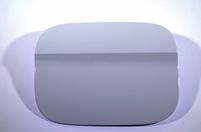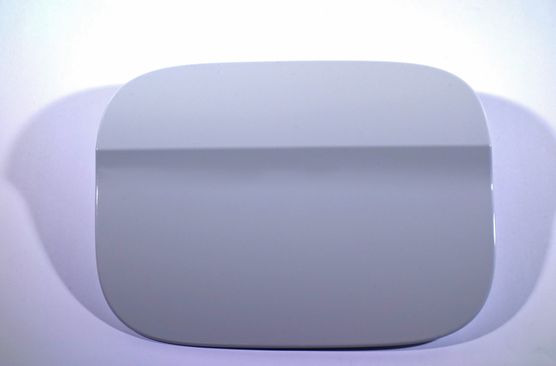Asia
EMEA

LANXESS Canada Contacts
Contact our Sites in Canada
Media Inquiries
General Inquiries
Please click here to e-mail LANXESS Canada with product inquiries and general requests.
Global Press Releases
2019-07-02
Class A-surface, outstanding mechanical properties
Online-paintable fuel filler flap made from PBT
- Cost-effective alternative to high-performance thermoplastics
- Can potentially also be used in flaps for electric vehicles
- Comprehensive customer service HiAnt for component development
Cologne – Customized compounds based on polybutylene terephthalate (PBT) can be a cost-effective alternative to high-performance thermoplastics in the production of fuel filler flaps. This can be seen in the new Skoda Scala, for example, whose fuel filler flap is made from Pocan B5221XF. The PBT compound was given preference over a blend of polyphenylene ether and polyamide (PPE+PA). “Our material is less expensive and exhibits comparable performance when it comes to surface quality, paintability and mechanical properties. In addition, it is suitable for electrostatic painting. It is also paintable online, which means that it can pass through all painting steps together with the vehicle body without any further outlay. This also contributes to cost-effective production,” says Dr. Stefan Theiler, who is an expert in plastic exterior parts in application development in the LANXESS High Performance Materials (HPM) business division. The plastic vehicle body component was jointly developed by Skoda, a TIER1 and LANXESS.
High dimensional accuracy, minimal warpage
Pocan B5221XF (Xtreme Flow) has been optimized to ensure good paintability and paint adhesion. Depending on the tool, smooth surfaces without unsightly sink marks can be achieved (Class A surface). The material is also suitable for electrostatic painting. When it comes to paint adhesion, standard OEM requirements – such as those defined in delivery regulations TL 211 from Volkswagen and DBL5416 from Daimler – are fulfilled. The paint layers adhere firmly to the plastic surface and can withstand the usual adhesion tests such as the cross-cut test to DIN EN ISO 2409 and steam-jet test to DIN EN ISO 16925.
The material, which is reinforced with 20 percent micro glass beads, exhibits isotropic shrinkage and a minimized tendency to warpage. This means that the fuel filler flap fits in perfectly with the rear fender. “This gives it the edge over polyamide blends, which are less dimensionally stable due to the tendency of polyamide to absorb water,” says Theiler.
Capable of withstanding the high temperatures of cathodic dip-coating
Another advantage of the PBT material is its high resistance to short-term temperatures. The heat distortion temperature as per ISO 75-1,-2 (HDT/B, 0.45 MPa) is 165°C, which means that the fuel filler flap can withstand the high temperatures that arise during both cathodic dip coating of the vehicle body and the drying steps of the painting process. As a result, the component can pass through the entire painting line together with the vehicle body (online painting). “This helps to cut costs during painting and in the logistics processes,” says Theiler. By contrast, mineral-filled PBT or PA compounds – which are also used for manufacturing fuel filler flaps – are not compatible with cathodic dip coating processes.
The extreme toughness of the PBT compound from LANXESS is yet another advantage, making the fuel filler flap highly robust against mechanical deformation (e.g. in the event of vandalism). Theiler: “Gasoline and diesel thieves will find it really hard to prise the flap open, even if they use force.”
Broad application potential
Pocan B5221XF can be processed at lower temperatures than (PPE+PA) blends. Its high flowability makes it easier to realize complex or large component geometries. “In addition to fuel filler flaps, we also envisage our material being used for exterior body parts such as spoilers and other components designed to improve vehicle aerodynamics as well as in antenna covers, flaps for electric vehicles and mirror housings,” says Theiler.
HiAnt – customer service that pays for itself
Through its engineering service HiAnt, LANXESS provided Skoda with comprehensive support in the development of the fuel filler flap. Under this brand, HPM has combined its expertise in material, application, process and technological development. For the fuel filler flap, for example, HPM conducted mold flow and warpage simulations in order to achieve the best-possible tool design and optimize the production process. Theiler: “Our aims here included correctly positioning the cooling ducts in the injection molding tool, defining the ideal parameters for tool tempering and calculating the optimum melting temperature.” In addition, HPM simulated critical load cases during component testing, such as the forceful opening of a sealed fuel filler flap in a body drop test. During the sampling process and start of series production, processing experts from HPM went directly to the injection molders and gave them recommendations for process parameters, reworking the tool (e.g. regarding gating and cooling system) and ventilation.
Forward-Looking Statements
This company release contains certain forward-looking statements, including assumptions, opinions, expectations and views of the company or cited from third party sources. Various known and unknown risks, uncertainties and other factors could cause the actual results, financial position, development or performance of LANXESS AG to differ materially from the estimations expressed or implied herein. LANXESS AG does not guarantee that the assumptions underlying such forward-looking statements are free from errors nor does it accept any responsibility for the future accuracy of the opinions expressed in this presentation or the actual occurrence of the forecast developments. No representation or warranty (expressed or implied) is made as to, and no reliance should be placed on, any information, estimates, targets and opinions, contained herein, and no liability whatsoever is accepted as to any errors, omissions or misstatements contained herein, and accordingly, no representative of LANXESS AG or any of its affiliated companies or any of such person's officers, directors or employees accept any liability whatsoever arising directly or indirectly from the use of this document.
LANXESS is a leading specialty chemicals company with sales of EUR 7.2 billion in 2018. The company currently has about 15,500 employees in 33 countries and is represented at 60 production sites worldwide. The core business of LANXESS is the development, manufacturing and marketing of chemical intermediates, additives, specialty chemicals and plastics. LANXESS is listed in the leading sustainability indices Dow Jones Sustainability Index (DJSI World and Europe) and FTSE4Good.
- Gallery




